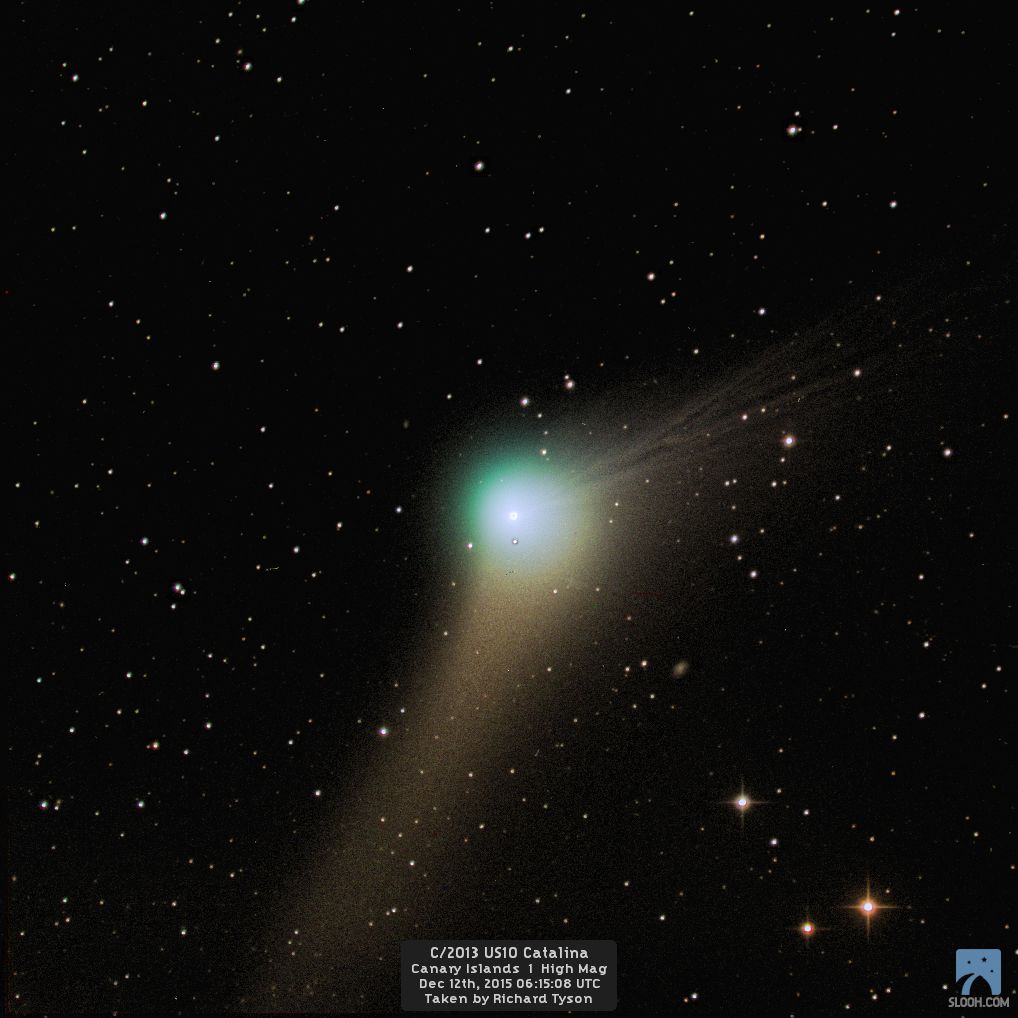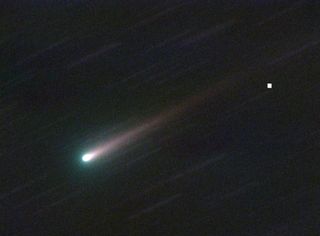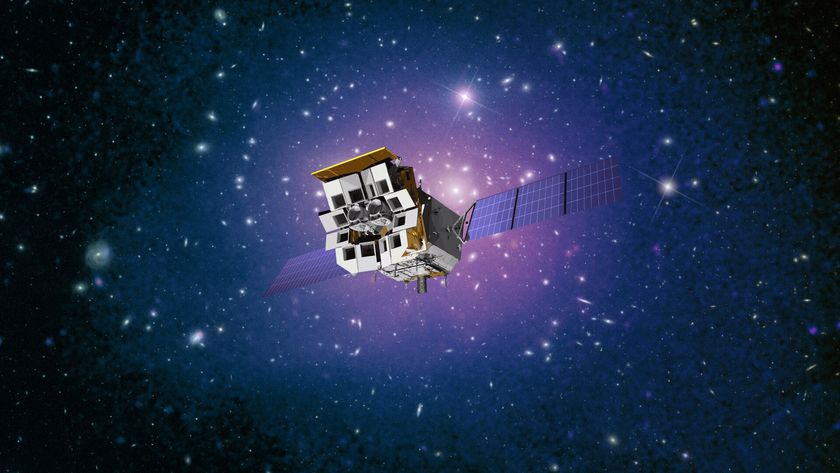
If you have already received, or expect to receive, binoculars or a telescope for the holidays, you're in luck. During the next several weeks, you'll have an interesting target to shoot for: a new comet.
The comet has been named "Catalina," but it has nothing to do with a rocky island off the coast of California, or swimwear (both of which share the name). Rather, the moniker refers to the Catalina Sky Survey (CSS), a project that aims to discover comets and asteroids as well as search for near-Earth objects. More specifically, the goal of the CSS is to search for potentially hazardous asteroids that may pose a threat of impact. Two telescopes, both located in southern Arizona, near Tucson, are used: a 60-inch (152 centimeters) telescope atop Mount Lemmon, and a 27-inch (69 cm) telescope near Mount Bigelow.
Discovered on Oct. 31, 2013, the comet was initially thought to be an asteroid early on in a periodic six-year orbit, until more observations were received and the orbit was refined. Researchers then found that the object in question was an inbound comet en route to the sun but still more than two years away from its closest approach to the sun (called perihelion). [See more great photos of Comet Catalina]
Space garbage
Scientists think comets are most likely leftover material from the formation of our solar system some 4.6 billion years ago — cosmic garbage, if you will.
They are composed chiefly of frozen gases and dusty material with the consistency of cigar ash that are heated as they approach the sun, whose energy makes them glow. As the gases warm and expand, the solar winds blow the expanding material out into the comet's beautiful tail. To observers in centuries past, the tail resembled a head of long hair, so they called comets "hairy stars."

Visibility is Improving
Comet Catalina made its closest approach about a month ago, on Nov. 15, at a distance of 76.5 million miles (123 million kilometers) from the sun. At that time, the comet was anywhere from difficult to impossible to see because it was mired in the bright dawn light and was very low relative to the east-southeast horizon. But with each passing day, the comet's visibility has slowly improved. Currently, it's relatively easy to spot as it sails northward through the eastern part of the constellation Virgo. At the break of dawn, the comet will be situated roughly halfway up in the south-southeast sky.
The comet is moving away from the sun, but it is now approaching the Earth. On Jan. 17, it will be at its closest point to Earth, at a distance of 67.4 million miles (108.4 million km). Shortly after the comet was discovered, there was talk that it might possibly become as bright as magnitude 3, making it an easy object to see with the naked eye. However, it now appears more likely that the comet's current level of brightness will not change very much over the next month or so, at least until it passes closest to Earth during mid-January.
Get the Space.com Newsletter
Breaking space news, the latest updates on rocket launches, skywatching events and more!
Right now, Comet Catalina is shining at around magnitude 6.4. That means that if you were blessed with a clear and very dark sky without light pollution and knew exactly where to look, you just might be able to pick the comet out against the stars — not by looking directly at it, but by peeking with averted/peripheral vision. In other words, the comet is right at the threshold of naked-eye visibility. However, that does not factor in bright moonlight; once the moon passes full phase on Christmas Day, it will become a significant hindrance, lighting up the predawn sky and then becoming less of a hindrance as it thins to a crescent after the first week of January.
Nonetheless, in good binoculars or a telescope, the comet should be readily visible and appear as a small, circular, hazy patch, perhaps with a bluish tinge. In photographs, the comet will have two tails. Its gas tail has shown intricate, rapidly changing structure, while its dust tail appears to be lagging the comet along its orbit. The position of the dust tail suggests larger particles were released some months prior to perihelion.
On the morning of Dec. 16, Long Island, New York-based amateur astronomer Rich Tyson noted, "I was able to observe Comet Catalina from Freeport, with my 12 x 63 binoculars. By star hopping, south, from [the star] Arcturus, I was able to locate the comet fairly easily. It appeared as a faint, roundish patch of light just north of the star Upsilon Virginis." Tyson added, "As Comet Catalina rises higher in the sky, it is getting easier to see. Street lights aren't as much of a problem as before." [Best Night Sky Events of December 2015 (Stargazing Maps)]
Oort dud?
Normally, a nice, fluffy comet would brighten intrinsically for some weeks after its closest approach to the sun. Combine this with an approach to the Earth, and that normally would spell a much brighter show. But unfortunately, Comet Catalina is a "virgin comet," having come straight out of the Oort Cloud — the supposed source of all comets — perhaps from a distance of 93 trillion miles (150 trillion km), or 100,000 times the Earth's distance from the sun. Such comets have never been exposed to the heat and light of the sun and have a propensity to initially brighten rapidly before ultimately "petering out" upon getting closer to the sun. That seems to be precisely what happened to Comet Catalina; it is possible the comet experienced an outburst in brightness during late July or August and has since spent the past several months fading back to "normal."
So the comet's receding from the sun might just be offset by the comet's approach to Earth, keeping it more or less unchanged in appearance.
John Bortle, a noted comet observer from Stormville, New York, said the comet is fading ever so slowly, in spite of its approach to Earth. "Given the comet's photometric history, particularly that over the past 6 weeks, a far more likely scenario is for its brightness to fade by perhaps 0.5 magnitudes in the course of the next 40 days,” Bortle noted Dec. 7 in an email to Space.com.
Benchmarks, then farewell!
Comet Catalina will be moving almost north in the coming weeks and should be relatively easy to follow as it tracks through Virgo for the balance of this month, then through kite-shaped Boötes (the Herdsman) during the first half of January and then past the Big Dipper in mid-January. A sky chart like this one, from Sky & Telescope, will prove quite useful.
If you're new to astronomy, there will be two occasions in the coming weeks where you can readily locate the comet near to two noteworthy benchmarks. On New Year's morning, Comet Catalina will be about a half degree (the apparent width of the moon) from the dazzling orange star Arcturus. You can find Arcturus by following the arc of the Big Dipper's handle, which will take you directly to that star. Then, on the morning of Jan. 18, the comet will be positioned just a couple of degrees to the upper left of Mizar, the famous double star in the middle of the Big Dipper's handle. The comet will be receding from both the sun and Earth, and will be fading more rapidly after that.
This will be Comet Catalina's first and only visit to the inner solar system. Small perturbations induced by the planets will send it with sufficient speed to be ejected from the solar system and into interstellar space, never to return.
Editor's note: If you capture an amazing photo of Comet Catalina (C/2013 US10) that you'd like to share with Space.com and our news partners in a possible story or gallery, send images and comments in to managing editor Tariq Malik at: spacephotos@space.com.
Joe Rao serves as an instructor and guest lecturer at New York's Hayden Planetarium. He writes about astronomy for Natural History magazine, the Farmer's Almanac and other publications, and he is also an on-camera meteorologist for News 12 Westchester, New York. Follow us @Spacedotcom, Facebook or Google+. Originally published on Space.com.
Join our Space Forums to keep talking space on the latest missions, night sky and more! And if you have a news tip, correction or comment, let us know at: community@space.com.

Joe Rao is Space.com's skywatching columnist, as well as a veteran meteorologist and eclipse chaser who also serves as an instructor and guest lecturer at New York's Hayden Planetarium. He writes about astronomy for Natural History magazine, the Farmers' Almanac and other publications. Joe is an 8-time Emmy-nominated meteorologist who served the Putnam Valley region of New York for over 21 years. You can find him on Twitter and YouTube tracking lunar and solar eclipses, meteor showers and more. To find out Joe's latest project, visit him on Twitter.
Most Popular




